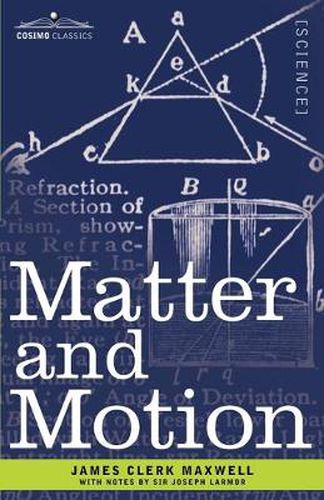Readings Newsletter
Become a Readings Member to make your shopping experience even easier.
Sign in or sign up for free!
You’re not far away from qualifying for FREE standard shipping within Australia
You’ve qualified for FREE standard shipping within Australia
The cart is loading…






This title is printed to order. This book may have been self-published. If so, we cannot guarantee the quality of the content. In the main most books will have gone through the editing process however some may not. We therefore suggest that you be aware of this before ordering this book. If in doubt check either the author or publisher’s details as we are unable to accept any returns unless they are faulty. Please contact us if you have any questions.
This slim yet dense volume remains an excellent introduction to Newtonian physics, just as when it was first published in 1877. Beginning with the basics of physical science and working his way steadily up to universal gravitation, Maxwell surveys late-19th-century physics in his clear and concise style. Matter and Motion addresses: . motion . force . the properties of the center of mass of a material system . work and energy . recapitulation . the pendulum and gravity . the equations of motion of a connected system Readers from the science historian to the high school physics student will come away from Matter and Motion with a deeper understanding of the roots of modern physics. Scottish physicist and mathematician JAMES CLERK MAXWELL (1831-1879) is considered by many to be one of the giants of theoretical physics. Albert Einstein once described Maxwell’s work as the most profound and the most fruitful that physics has experienced since the time of Newton. A devoutly religious man and a published poet as well as a renowned scientist, Maxwell’s books include Theory of Heat (1870), Treatise on Electricity and Magnetism (1873), and Elementary Treatise on Electricity (1881).
$9.00 standard shipping within Australia
FREE standard shipping within Australia for orders over $100.00
Express & International shipping calculated at checkout
This title is printed to order. This book may have been self-published. If so, we cannot guarantee the quality of the content. In the main most books will have gone through the editing process however some may not. We therefore suggest that you be aware of this before ordering this book. If in doubt check either the author or publisher’s details as we are unable to accept any returns unless they are faulty. Please contact us if you have any questions.
This slim yet dense volume remains an excellent introduction to Newtonian physics, just as when it was first published in 1877. Beginning with the basics of physical science and working his way steadily up to universal gravitation, Maxwell surveys late-19th-century physics in his clear and concise style. Matter and Motion addresses: . motion . force . the properties of the center of mass of a material system . work and energy . recapitulation . the pendulum and gravity . the equations of motion of a connected system Readers from the science historian to the high school physics student will come away from Matter and Motion with a deeper understanding of the roots of modern physics. Scottish physicist and mathematician JAMES CLERK MAXWELL (1831-1879) is considered by many to be one of the giants of theoretical physics. Albert Einstein once described Maxwell’s work as the most profound and the most fruitful that physics has experienced since the time of Newton. A devoutly religious man and a published poet as well as a renowned scientist, Maxwell’s books include Theory of Heat (1870), Treatise on Electricity and Magnetism (1873), and Elementary Treatise on Electricity (1881).